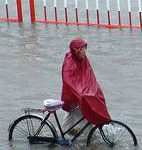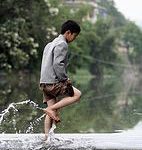Naomi Li: The IPE website looks like a daring project. You map out levels of water pollution in various parts of China, and even name companies whose pollution discharges exceed statutory levels. What made you embark on this project?
Ma Jun: Water pollution is the most serious environmental issue facing China. It has a huge impact on people’s health and economic development. That is why we have begun to build this database. To protect water resources, we need to encourage public participation and strengthen law enforcement. In some places, polluting factories and companies are being protected by local governments and officials. The public need to take part in water monitoring and management if the situation is to improve. The first step to get the involvement of the public is to inform them.
NL: Please explain the water crisis in contemporary China.
MJ: China is facing a water crisis that includes water shortages, water pollution and a deterioration in water quality. 400 out of 600 cities in China are facing water shortages to varying degrees, including 30 out of the 32 largest cities. In the north, due to the drying up of the surface water, the underground water has been over-extracted. The situation is not sustainable. Though the south has abundant water, there is a lack of clean water due to serious water pollution. Even water-abundant deltas like the Yangtze and the Pearl River suffer from water shortages. Water pollution and shortages are negatively intertwined. Water pollution can not be diluted for lack of clean water; and yet more emissions of pollutants into the water damage the already limited amount of clean water. Now water pollution has started to affect people’s health. We have some figures to demonstrate that discharges of waste water have increased continually over the past five years. 70% of the rivers we have monitored have been polluted at various levels; 90% of the shallow aquifer in urban underground water has been polluted. According to statistics, 300 million peasants’ drinking water is not safe; water quality in one fifth of the main cities is not up to standard. Discharges of toxic and harmful chemicals into the sea are absorbed by marine organisms, and as a result our health is affected through the food chain.
NL: How do you collect your data?
MJ: China has passed several laws on information disclosure in the past few years. Our figures mostly come from government agencies such as environmental protection agencies, and we also use information from other sources such as water conservation agencies, sea monitoring and construction agencies. Some information is from the media, particularly in relation to the 2500 companies that have been named. The figures will be updated regularly. Some localities issue annual reports while others have half-yearly reports. We will renew the figures accordingly. As per figures on sources of pollution, we will keep them up to date and fill in any information that will be reported by media.
NL: What do you expect the benefit to be of putting it together in one place?
MJ: Though a lot of the figures collected on our website have been publicised by government agencies, they are scattering around in various places and not easily accessible to people. We collated and put them together in order to present a clear and comprehensive picture to the public.
NL: Are there plans to produce a version in any other language? English for instance?
MJ: The website’s front page has been translated into English, as well as the rankings. But most content is not yet available in English due to the huge work and cost it might entail.
NL: There are 2,500 offending companies named on your website?
MJ: Yes. I hope those companies we have named will view this in a positive way. Of course, we are not an anti-business organisation. But I think that in a healthy market environment, companies should carry out their social and environmental responsibilities. If they take their corporate social responsibilities seriously, they will be able to gain understanding and trust from the communities in which they operate.
But the premise is that companies should feel some force of pressure from the public. Up to now, companies haven’t felt much pressure from the public regarding their environmental performance. A lot of them still believe they can just close their doors and shut their ears to concerns from the public. This is convenient, cost-saving and trouble-free. But the situation is changing, as the public’s concern for the environment grows, I hope those companies with vision would take the initiative to communicate with the communities in which they operate. I hope we can get to the position where, one day, companies will explain to the public what toxic and harmful chemicals they use in their operations, and what measures are being taken to combat their harmful effects, as well as the necessary preparations to minimise damage if an incident occurs.
We notice that in the west, if companies are serious about their social responsibility, they will enjoy an increase in the value of their brand name. I hope Chinese companies will gradually learn this trick. Most of the companies listed are Chinese owned, however, there is no lack of multi-national companies too. I feel some regret that these MNCs appear in this list, as they seem to have a good record internationally in terms of environmental issues. I hope they would take the lead, and stop discharging levels of pollutants that exceed statutory limits. Shanghai has publicised a comprehensive list of offending companies, with over 1000 names, among which over 200 have something to do with water pollution. Over a dozen MNCs are included in the list, such as DuPont, several Japanese companies including Panasonic and KFC restaurants.
NL: Chinese environment laws stipulate legal sanctions against offending companies. Why does this not stop some companies from polluting?
MJ: Water issues present a dichotomy between development and environmental protection. The central government has adjusted some of its strategies and policies, but at a local level, officials still place too great an emphasis on economic development. As a result, local government officials offer protection to some so-called pillar industries – those companies that generate revenue for local economy. Such protection makes it difficult for the local environmental watchdogs and local courts to punish offending companies. So some local businesses are able to get away with their bad behaviour, and yet the people who are affected by the pollution have a very weak voice.
NL: What kind of co-operation do you have with other environmental organisations?
MJ: we combine the map with figures on our website, so it is visually easy to find the location of polluting sources and relevant figures and information. We need to investigate and then locate the polluting sources on the map. Pollution sources are spread all over china, so we need to work with local environmental organisations. Now we started to work with Green Home, an environmental NGO in Beijing in investigating sources of water pollution. According to some information revealed by Beijing government, we traced them to the suburbs of Beijing. Some companies and factories located in a industry park haven’t installed water treatment facilities, or some simply do not comply with the discharge rules. After our field trip, we then put this information onto our digital map. I hope people not only use digital map to locate where to eat and where to have fun, they will also use it to understand who is polluting our rivers.
NL: What is the role of the public in your project? If anyone wants to help how do they to get involved?
MJ: China faces a huge water problem. It can’t be solved by giving an order by a single person, neither can it be achieved by one man’s efforts. It needs consensus from the whole society. Only if the whole society are mobilised that this problem can be resolved. We put this information together for the convenient reference and usage by the public, so they can refer to some figures in their efforts to monitor pollution. We went to give a speech at a journalists’ salon the other day. We were told by the audience about their individual action plans, some are in the initial stages, and some are in the implementation stages. We need to collate more information and employ technologies to consolidate the public efforts, and to explore solutions to the water problem.
Water problem is particularly worse in medium-size cities and countryside. Some NGO from such places want to join us. We also offer training and give speeches to them.
NL: How is this project funded and how many staff are working on it?
MJ: We started collecting data and building this website since May. We have four full-time staff and more than 10 part-time students who have helped us input data and do some mapping work. We gain some support from companies who specialise in data developing and digital map. We are also offered office space and equipment by a company. Apart from that, we receive some fund from a couple of companies who share our vision of environmental protection. We are also in the process of writing a few China water pollution reports and one of them will be completed by the end of this year. I hope there will be more and more support for environmental research in China.
The authors:
Ma Jun’s book China’s Water Crisis (1999) was described in Time magazine’s “100 People Who Shape Our World” as China’s “first great environmental call to arms”. He is the director of Institute of Public and Environmental Affairs, the organisation that produces the China Water Pollution Map website, which was launched on September 14, 2006. He is also an environmental consultant with Sinosphere Corporation.
Naomi Li is a freelance writer based in London. She was recently involved in the production of a BBC television documentary on the environmental challenges facing China.





